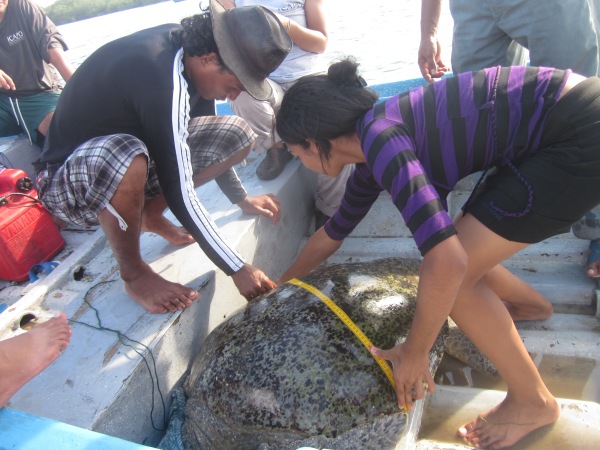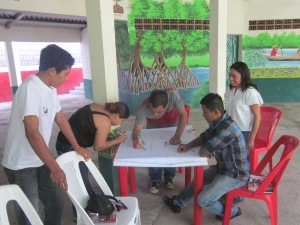Youth leading the way to protect natural resources in the Bay of Jiquilisco
“Tortuga! Tortuga!” a choir of excited young adults shouted from a boat patrolling the Bay of Jiquilisco. A head was just spotted popping out of the water, and within minutes three spry bodies had hit the water and were hoisting the well-over 100 lbs. green sea turtle over the side of the boat for a closer look. For the youth, who come from the communities that surround the Bay of Jiquilisco, it is the first time many have been on the Bay and first time any have ever seen a sea turtle. An anxious chatter fills the bay-air as the boat rocks back and forth with the enthusiasm of eager, young citizen scientists jostling to get a closer look at the amazing creature. Alongside the skilled staff of the Eastern Pacific Hawksbill Initiative (ICAPO), the youth collect data, measuring the length and width and helping to tag and collect a tissue sample of the awe-inspiring specimen.
In partnership with ICAPO and SEE Turtles, over the past two weeks more than 20 youth leaders from the communities of Puerto Parada and the Bajo Lempa visited the island community of La Pirraya in the Bay of Jiquilisco to conduct hands-on research, visit hatcheries, and explore the ecosystem of the four species of sea turtles found in the Bay, including the critically endangered hawksbill sea turtle. Interacting with biologists, conservationists, local fishermen, and community members, participants discussed the threats facing the sea turtle population and their ecosystem in the Bay of Jiquilisco, how community-led initiatives are protecting the turtles and their environment while sustaining livelihoods, and what they can do to help.
The visits are part of a larger curriculum for the Mangrove Association youth group designed to provide opportunities for youth to build relationships with one another, organize around environmental conservation, and learn about community-led projects in different parts of the region, all while developing leadership skills that will benefit themselves and their communities. The curriculum began with environmental education workshops where youth created and presented natural resource maps illustrating their relationship to the ecological attributes that make their home a UN Biosphere and Ramsar site, and what those international designations mean. The youth group has since written, recorded, and edited several public service announcements that raise awareness about environmental issues affecting their communities including pollution, deforestation, harmful agricultural practices, and blast fishing, among others. The PSAs, broadcast to over 200 communities on Radio Mangle, advocate for the protection of water, mangrove forests, sea turtles, soil, and other natural resources.
There are also plans to visit various community-led initiatives that are confronting these threats to the natural resources and livelihoods of communities. In the coming months, members of the youth group will visit the coastal communities of Montecristo and Isla de Méndez to learn about local natural resource management projects such as a crab hatchery that is repopulating the historically over exploited species while also providing a sustainable source of sustenance and income for the cooperative of community members that run it. They will also tour sites of ecological mangrove restoration to speak with local engineers and wildlife rangers about the importance of wetlands to the environment and their communities.
On the boat ride back from La Pirraya, as the sun set over the volcanoes that surround the Bay of Jiquilisco, the youth spoke of how they couldn’t wait to share their experience and new found knowledge with their friends and family. They shared their curiosity to learn more about the natural resources upon which their livelihoods depend and their desire to do more to protect them. They questioned harmful practices they had seen at work in their communities and collaborated on what they could do to change them. They sounded like young community leaders ready to make a difference.







Desde la perspectiva de nuestra juventud y mas aun siendo parte de los cambios, estamos consientes que en nuestras manos esta el destino que le daremos a nuestros recursos en la Bahía de Jiquilisco, y el Bajo Lempa, vivo en Montecristo comunidad ubicada en el sector occidental de la Bahía, me siento orgulloso de ser parte de un proceso en pro de la conservación, restauración, protección y aprovechamiento sostenible de los recursos naturales, vamos por el desarrollo de las comunidades vinculando procesos sociales importantes para lograr nuestros objetivos esto es posible gracias a la convicción de los pobladores y lideres locales, pero no solo eso, si no que también a la cooperación y presencia de las organizaciones locales que son nuestro canal de gestión gracias Ecoviva.